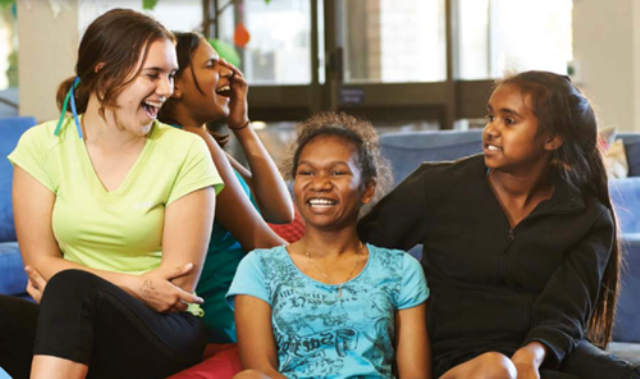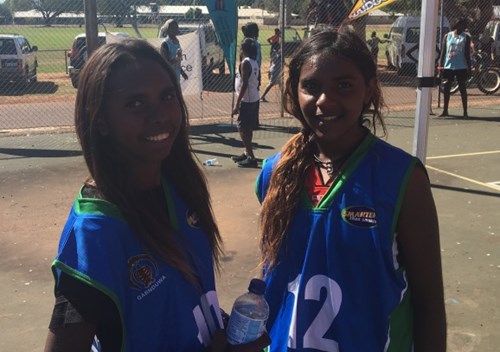“Other things worry me too like what if the world keeps going the way it is and no one is prepared to make change and be nicer to each other. Right now it feels like nothing is going to change and people are not coming to together like they should.” Jay, 17-year-old young person, Caversham
Stage 4 - Following up with Aboriginal children and young people

This stage requires you to provide and receive feedback to and from the Aboriginal children and young people you have engaged with, to ensure that you accurately reflect and incorporate the information provided by participants during the activity, to inform your participants and their community and to develop your practice for next time.
Stage 4 has three steps:
Step 1
Give them feedback
“Dancing is great. It lets you see other people’s points of view and teaches us about how when you work together you can create something amazing.” 12 year-old young person, Midland
Children and young people have given time, energy and commitment to your project and it is important to them. Children and young people have the right to receive feedback on how their involvement in your organisation’s/agency's participation processes influenced and affected the decision making process, and to see that their contribution made a difference.
Provide feedback from the beginning through two-way conversation, using methods preferred by Aboriginal children and young people. Ask them how they would like to be contacted with feedback and how they would find it easiest to provide you with theirs.
Important feedback includes:
- acknowledging their attendance and work they completed (personally and also publicly through your organisation’s/agency's website, social media and community-based platforms)
- describing and evidencing how their views have been responded to and influenced your work, including any actions taken and decisions made
- updating them about the project’s progress and explaining changes (including delays) to the plan
- allowing them to review and comment on documents that record their views prior to circulation/publication to double check the accuracy of the analysis and interpretation as well as improve program design and outcomes
- providing an opportunity for and responding to queries, requests and suggestions
- your response(s) to their feedback received so far
- share the value/praise of their contribution with community stakeholders.
Step 2
Get their feedback
“Thank you for listening to me because it finally gave me a chance to speak.” Young person of unknown age, South West
Asking Aboriginal children and young people for feedback about what it was like to be involved in the process will improve your participation activities in the future, improving results for Aboriginal children and young people and your organisation/agency.
Seek feedback by:
- observing children and young people’s body language and behaviour – use their feedback to adjust what you are doing as you are doing it, for example change the activity, the pace or have a break.
- asking them what they thought about an activity (individually and collectively)
- reviewing at the end of the activity (for example through a yarning circle or while sharing a meal)
- providing an opportunity for anonymous feedback (such as a survey or ideas box).
There a variety of tools that can be used to collect feedback, including stories, activities, child-friendly questionnaires, yarning circles and role play.
Models of Participation, Involving Children in Decision Making - Commissioner for Children Tasmania
When asking Aboriginal children and young people for feedback after a workshop or activity, ask about their experience of participating, including:
- what went well, what they enjoyed
- what they learnt
- what could be done differently
- if they feel they were taken seriously and treated fairly
- if they feel they were listened to and safe (including in their identity and culture)
- what they think of the action or outcomes
- what they would like in the future.
Seeking the feedback of Aboriginal children and young people also helps to increase the evidence base around the issues affecting them and how best to achieve positive outcomes for Aboriginal children and young people. This is important to improve policy and practice, to design effective interventions and use as a basis for advocacy.
Case study extract
Kununurra Empowering Youth (KEY) – Feedback
KEY has continued to evolve its feedback process as a reflection tool for the success of past programs, a planning tool for future programs and a way of demonstrating anecdotal success of the program.
“Feedback from young people was obtained after the school holiday period, which contributed to the next phase of planning for future school holidays programs – many young people reported attending more than one event as part of the school holiday program; they were positive about family/community involvement and felt more confident about talking to agency staff at these events.”

Step 3
Make sure you’ve delivered
“Listen to what young people have to say, and if you promise you are going to do something, do it, otherwise their trust in adults diminishes.” Dianna Wright29
It is important to deliver on what you agreed on in the beginning. If a different outcome or project has resulted from the consultation or participation activity, you will need to re-negotiate this, and any additional activities arising from it, with the community as part of your reporting back.
This can be particularly important when you don’t receive the kind of engagement or results you expected, to ensure the approach or program is improved for future activity.
Formally monitoring and evaluating how well Aboriginal children and young people’s participation is working for them and for your organisation/agency is an important part of this. Evaluation should be embedded in the process from start to finish. It provides opportunities to reflect on the strengths and weaknesses during and on completion of the process.
Involving Aboriginal children and young people in the evaluation process can improve the quality and integrity of the evaluation and be empowering for them. When involved in the evaluation, young people will often feel more ownership and commitment to the initiative and its aims. It also supports their development as young leaders as it is an opportunity to think critically and express their views.
Go to Section 5 - Case studies
Explore the toolkit
References
29. Young Panel member, Children’s Week Forum 2008: Making a positive difference in the lives of WA’s children, Commissioner for Children and Young People WA.



